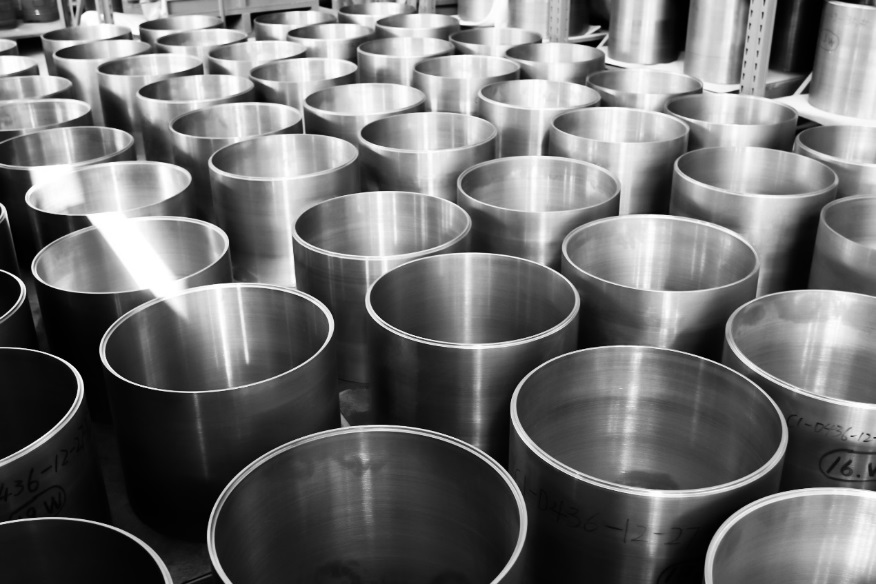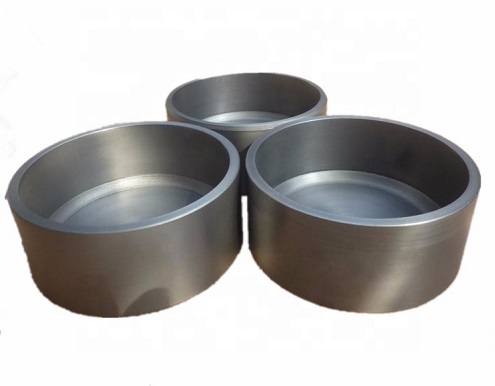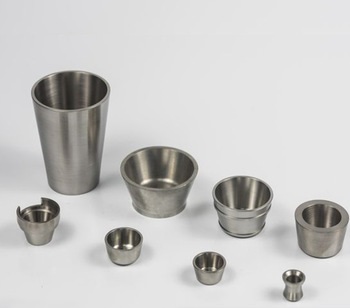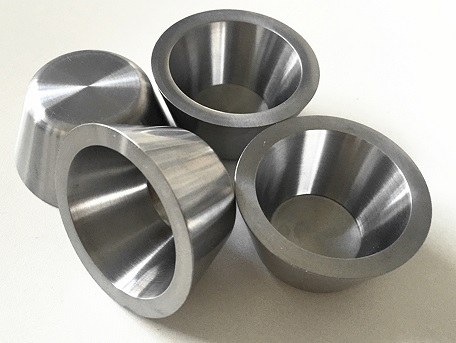
A tungsten crucible is one of the products of the tungsten metal. As the melting point of tungsten is as high as 3410℃, the tungsten crucibles can be divided into spinning, stamping, forging, and sintering according to different manufacturing processes.
It refers to the tungsten crucible produced by spinning forming. The process of shear spinning of conical parts or flow spinning of cylindrical parts can be used to prepare a tungsten crucible by spinning forming.

spinning tungsten crucible
Firstly, the tungsten billet was prepared by powder metallurgy, and then rolled into thin plates of designed thickness by the hot rolling process, and then processed into circular sheets, which were then placed on a hot spinning machine. The tungsten plate remains concentric with the mold on occasion. After spinning many times, the shape of the tungsten plate changed into a crucible, while the thickness of the tungsten wall became thinner and adhered to the mold. After cooling, the spinning tungsten crucible was obtained.
During spinning, hydrogen and compressed air are mixed with the flame for heating. The heating temperature is about 1000℃, and the wall thickness of each pass is controlled at about 0.5mm. When the processing rate reaches 50% ~ 70%, 1000 ~ 1100℃ hydrogen insulation for 1h annealing treatment is generally adopted to eliminate internal stress and increase plasticity, so as to further spin.
It is a tungsten crucible produced by a stamping process, which has the advantages of good surface quality, high dimensional accuracy, high material utilization rate, lightweight, simple preparation process, high production efficiency, and low production cost.
The production process of it mainly includes three steps: blanking, bending, and drawing:
1. Blanking is the general term of the separation process, including cutting, blanking, punching, punching lack, punching groove, cutting, gouging, cutting edge, cutting tongue, trimming, etc.
2. Bending is a stamping process that uses pressure to produce plastic deformation of material so that it is bent into shape with a certain curvature and a certain angle.
3. Deep drawing is a stamping process in which flat wool or process parts are changed into hollow parts or the hollow parts are further changed in shape and size. In deep drawing, hollow parts are formed by material flowing into the die, which is located outside the bottom of the punch.
It refers to the tungsten crucible prepared by the forging process, which mainly includes three steps blank preparation, forging, and machining. Its density is generally greater than 19.0g/cm3, which is almost reaching the theoretical density, while its diameter is generally less than 100mm.
The tensile strength and deformation resistance of the tungsten crucible produced by the forging method is better than those produced by other methods.

Forged Tungsten Crucible
The production process of forging tungsten crucible:
1. According to the requirements of tungsten crucibles, the size and mass of the tungsten rod are calculated. The relative density of the blank is generally 90% ~ 95%.
2. The prepared tungsten bar was heated to the blank opening temperature (1400 ~ 1600℃) in the hydrogen furnace, and after a period of heat preservation, the blank was forged, and then the blank was heated and forged again. After several forgings, the total deformation of the billet reaches 50% ~ 60% and the shape size conforms to the design size, then the forging process is completed.
3. Anneal the forged billet and process it according to the size of the finished product.
It is the tungsten crucible produced by the isostatic pressure-sintering method. The isostatic pressure-sintering mainly includes a batch of raw materials, powder loading, isostatic pressure pressing, high-temperature sintering, car processing, finished product inspection, and other procedures. This method is one of the main preparation techniques for producing tungsten crucibles.
The main factors of cracking in sintered tungsten crucible are powder mixing, pressing pressure, the size of the rounded corner at the bottom of the die core, the speed of sintering rise and drop, etc.

Sintering Tungsten Crucible
The production process of sintered tungsten crucibles:
1. Assemble the mold according to the size required by the blank loading, put the tungsten powder raw material that meets the requirements of national standards into the mold, seals it, and put it into the cold isostatic press for pressing. The forming pressure is generally 180 ~ 250MPa.
2. The blank is sintered in a high-temperature induction sintering furnace. The heating rate is 80 ~ 150℃/h, the highest temperature is 2200 ~ 2400℃, and the heat preservation time is 4 ~ 8h.
3. The blanks are processed according to the requirements of the finished products.
4. Inspect the appearance, dimension, and density of finished products.
Advanced Refractory Metals (ARM) supplies people with high-quality refractory metals all over the world. Please visit https://www.refractorymetal.org for more information.
Copyright © 1994-2024 Advanced Refractory Metals owned by Oceania International LLC, All Rights Reserved.